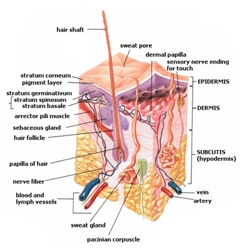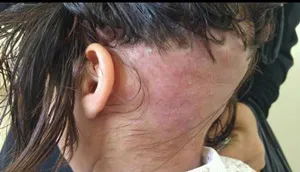
Folliculitis Is Infection Of Hair Follicles
 Folliculitis Is Infection Of Hair Follicles
Folliculitis Is Infection Of Hair Follicles
Folliculitis sounds like it could be a pretty serious medical condition. While it may sound scary, it actually sounds worse than it really is.
Folliculitis is basically the inflammation of one or more hair follicles. Folliculitis can occur anywhere on the body where there is skin present.
Folliculitis which generally looks like little red pimples develop from the basic bacteria strains which include Staphylococcus aureus (Staph) and Pseudomonas aeruginosa.
The infection may also appear as small, white-headed pimples around one or more hair follicles . Hair follicles are the tiny pockets from which each hair grows.
It may also develop from a pimple or pustule located around a hair follicle. While it typically occurs on the neck, in the armpit or through the groin area, it can also occur on the scalp or with certain hairstyles. For example, braids which are woven too tight and too close to the scalp may develop folliculitis. It can also happen as a result of blocked follicles.
Depending on how the folliculitis develops, it can become a full blown rash, may crust over or even spread to other parts of the body. It may be painful to the touch, itch or in serious situations, become an abscess or a boil. An area can also crust over, especially if disturbed.
 Most cases of folliculitis are superficial, and while they may itch, but on occasion they're painful too. Even mild folliculitis can be uncomfortable and embarrassing, depending upon where on the body it occurs.
Most cases of folliculitis are superficial, and while they may itch, but on occasion they're painful too. Even mild folliculitis can be uncomfortable and embarrassing, depending upon where on the body it occurs.
Superficial folliculitis
Superficial forms of folliculitis include:
- Staphylococcal folliculitis. When hair follicles become infected with Staphylococcus aureus (staph) bacteria. Barber's itch known as Sycosis barbae is a common infection of the hair follicles in the bearded area of the face, usually along the upper lip. Shaving usually aggravates the condition. Barber's itch is a staph infections.
- Pseudomonas folliculitis (hot tub folliculitis). Hot tub folliculitis is caused by the bacterium Pseudomonas aeruginosa. The folliculitis usually occurs after sitting in a hot tub which was not properly cleaned before use.- Tinea barbae. Caused by a fungus rather than a bacterium, this type of folliculitis develops in the beard area in men, causing itchy, white bumps.
- Pseudofolliculitis barbae. An inflammation of the hair follicles in the beard area, pseudofolliculitis barbae affects men when shaved hairs curve back into the skin.- Pityrosporum folliculitis. Especially common in teens and adult men, pityrosporum folliculitis produces chronic, red, itchy pustules on the back and chest and sometimes on the neck, shoulders, upper arms and face. It's caused by the yeast-like fungus.
- Herpetic folliculitis. Shaving through a cold sore. A small, fluid-filled blister caused by the herpes simplex virus can sometimes spread the herpes infection to neighboring hair follicles.- Folliculitis keloidalis involves scarring on the nape of the neck which is most common among males of curly hair.
- Folliculitis decalvans or tufted folliculitis usually affects the scalp. Several hairs arise from the same hair follicle. Scarring and permanent hair loss may follow. The cause of this condition is unknown.Deep folliculitis
Types of deep folliculitis include:
- Gram-negative folliculitis. This sometimes develops if you're receiving long-term antibiotic treatment for acne.
- Boils and carbuncles. These occur when hair follicles become deeply infected with staph bacteria.- Eosinophilic folliculitis. Seen primarily in those with HIV, this type of folliculitis is characterized by recurring patches of inflamed, pus-filled sores, primarily on the face and sometimes on the back or upper arms.
Possible Causes
Causes of folliculitis may include skin chafing or persistent rubbing along the skin from clothing. Folliculitis could occur as a direct result of an ingrown hair where the hair curls back or sideways into the skin. Ingrown hairs are seen primarily with people who have curly or naturally textured hair.
Folliculitis can also occur from "razor bumps" (pseudofolliculitis barbae), which vary in size. While ingrown hair most commonly appears in areas where the skin is shaved or waxed (beard, legs, pubic region), it can appear anywhere. Anything which causes the hair to be broken off short with a sharp tip can cause ingrown hair. Shaving is the leading cause, followed by waxing and tight clothing.
The ingrown hair condition is seen primarily among people having curly hair. It may or may not be accompanied by an infection of the hair follicle (folliculitis) or "razor bumps" (pseudofolliculitis barbae), which vary in size. While ingrown hair most commonly appears in areas where the skin is shaved or waxed (beard, legs, pubic region), it can appear anywhere.
Some experts believe that iron deficiency anemia is connected with chronic cases of folliculitis.
Treatments
Superficial folliculitis often clears by itself in a few days to a week. Deep, recurring or severely infected folliculitis may require medical treatment. In a worse case scenario severe folliculitis may cause permanent hair loss, scarring.
How is folliculitis treated? Hot web compresses may help in some cases. Topical antiseptic treatment is adequate for most cases.
Antibiotics Or Fungal Treatments
It's always recommended that a primary health care physician be consulted. Depending upon the situation antibiotics (mupirocin, neomycin) or antifungal medications may be prescribed to help control the situation.
Some patients may benefit from systemic narrow-spectrum penicillinase-resistant penicillins (such as dicloxacillin in US, or flucloxacillin in UK).
Fungal folliculitis can worsen with antibiotics and may require an oral antifungal such as Fluconazole. Topical antifungals such as Econazole Nitrate may also be effective.
Risk Factors
Some people are more prone to develop folliculitis than other. Those more at risk? People with diabetes or compromised immune systems such as from HIV/AIDS, hepatitis, chronic illnesses, cancer, systemic chemotherapy or immune-suppressing drugs.
More Information
Please follow me on Twitter at: http://Twitter.com/HairBoutique. I look forward to meeting new people from all walks of Twitter and learning from their Tweets. Visit us at Hairboutique.com located at: http://www.HairBoutique.com, on Facebook, MySpace and YouTube.
Thank you for visiting us at The HairBoutique Blog and for leaving your comments. They are very much appreciated. We apologize in advance, but must remove any direct advertisements or solicitations.Social Media Network Information
Please follow us on Twitter at: https://Twitter.com/HairBoutique. I look forward to meeting new people from all walks of Twitter and learning from their Tweets.













